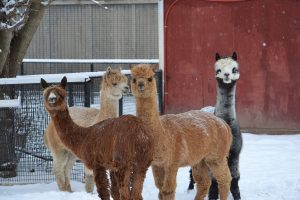Characteristics
They are the smallest domesticated camelid species, characterized by a slender neck and body. Their heads are small with big and pointed ears. Their fur can be either one solid color or multicolored. Their coats can come in 22 different colors. There are two breeds of alpacas: Huacaya and Suri. The most abundant is the Huacaya, which has crimped, fluffy wool. Suri Alpacas have silky hair that grows very fast.
Behavior
Alpacas are social and live in herds that may have other alpacas or llamas, goats, and sheep. There is some research that shows they may have a hierarchy system in their herds. Alpacas will pose in different directions to communicate and also make a wide range of vocalizations, including clicking, humming, and grumbling. If they feel threatened, they will let out an alarm call and may flee or investigate the danger.
 Did You Know?
Did You Know?
- Llamas and alpacas can be bred together, and that is called a Huarizo.
- They use communal dung piles to deposit their urine and feces.
- Alpaca are the domesticated descendants of vicuña.
Reproduction
Alpacas are polygynous and can breed year round. After mating, gestation takes about 242-345 days. The females usually give birth to one offspring that is precocial. The offspring will be weaned around six to eight months and females will reach sexual maturity around one years old. It takes the males about 30-36 months before they are sexually mature.
 Our Animals
Our Animals
Potter Park Zoo has 6 alpaca in our farmyard. Mac, Junior, Remington and Image live together next to the guinea hogs. Frank and Lola can be found living together with the Dexter cattle.



